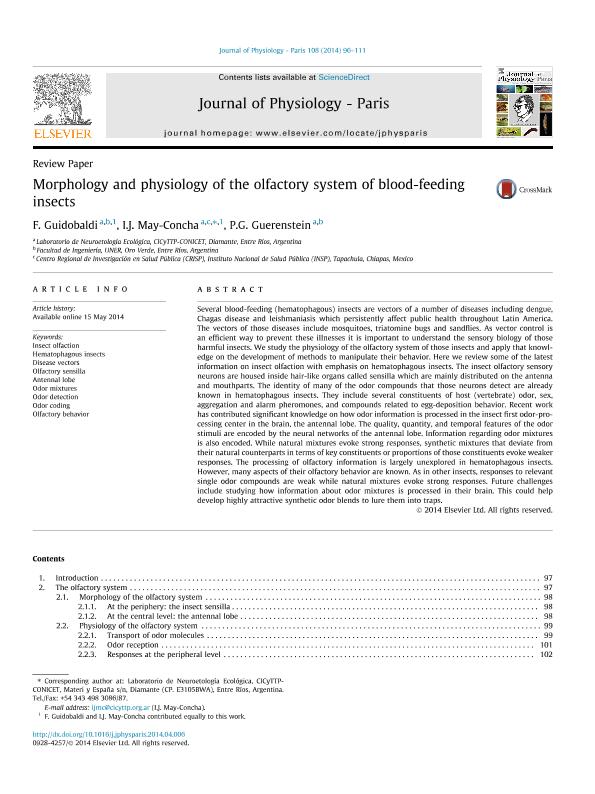Artículo
Morphology and physiology of the olfactory system of blood-feeding insects
Fecha de publicación:
04/2014
Editorial:
Elsevier
Revista:
Journal of Physiology
ISSN:
0928-4257
Idioma:
Inglés
Tipo de recurso:
Artículo publicado
Clasificación temática:
Resumen
Several blood-feeding (hematophagous) insects are vectors of a number of diseases including dengue, Chagas disease and leishmaniasis which persistently affect public health throughout Latin America. The vectors of those diseases include mosquitoes, triatomine bugs and sandflies. As vector control is an efficient way to prevent these illnesses it is important to understand the sensory biology of those harmful insects. We study the physiology of the olfactory system of those insects and apply that knowledge on the development of methods to manipulate their behavior. Here we review some of the latest information on insect olfaction with emphasis on hematophagous insects. The insect olfactory sensory neurons are housed inside hair-like organs called sensilla which are mainly distributed on the antenna and mouthparts. The identity of many of the odor compounds that those neurons detect are already known in hematophagous insects. They include several constituents of host (vertebrate) odor, sex, aggregation and alarm pheromones, and compounds related to egg-deposition behavior. Recent work has contributed significant knowledge on how odor information is processed in the insect first odor-processing center in the brain, the antennal lobe. The quality, quantity, and temporal features of the odor stimuli are encoded by the neural networks of the antennal lobe. Information regarding odor mixtures is also encoded. While natural mixtures evoke strong responses, synthetic mixtures that deviate from their natural counterparts in terms of key constituents or proportions of those constituents evoke weaker responses. The processing of olfactory information is largely unexplored in hematophagous insects. However, many aspects of their olfactory behavior are known. As in other insects, responses to relevant single odor compounds are weak while natural mixtures evoke strong responses. Future challenges include studying how information about odor mixtures is processed in their brain. This could help develop highly attractive synthetic odor blends to lure them into traps.
Archivos asociados
Licencia
Identificadores
Colecciones
Articulos(CICYTTP)
Articulos de CENTRO DE INV.CIENT.Y TRANSFERENCIA TEC A LA PROD
Articulos de CENTRO DE INV.CIENT.Y TRANSFERENCIA TEC A LA PROD
Citación
Guidobaldi, Fabio; May Concha, Irving Jesus; Guerenstein, Pablo Gustavo; Morphology and physiology of the olfactory system of blood-feeding insects; Elsevier; Journal of Physiology; 108; 2-3; 4-2014; 96-111
Compartir
Altmétricas




